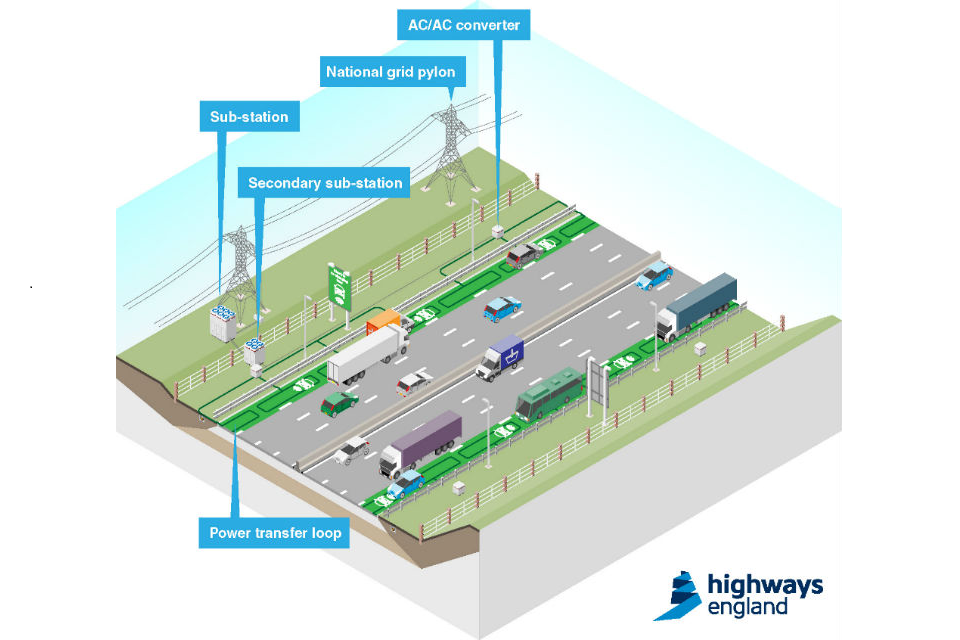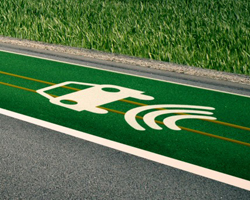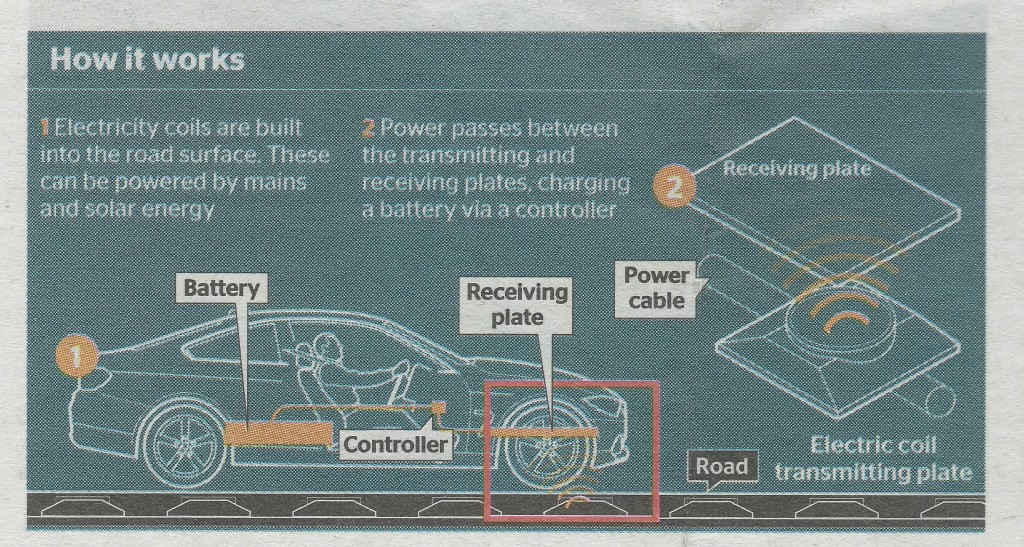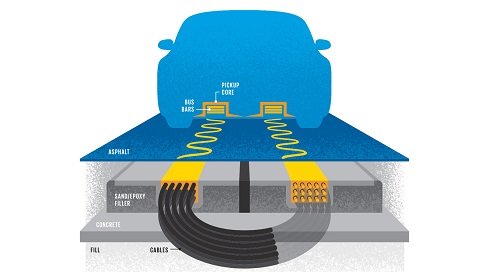Bumps in the Road > Wireless Charging Along Roadways

 Again, while abroad back in August, I picked up a copy of The Times whereupon I spotted more on the subject of my blog post of 10/2/13: energy recovery when driving. Now comes what the article referred to as Scalextric-style roads.
Again, while abroad back in August, I picked up a copy of The Times whereupon I spotted more on the subject of my blog post of 10/2/13: energy recovery when driving. Now comes what the article referred to as Scalextric-style roads.
The earlier post reported on the subject of energy recovery in a car’s suspension system when driving a hybrid FEV (fuel efficient vehicle) or electric LEV (low emitting vehicle). A German engineering partnership had produced the first vehicle suspension system able to transfer absorbed energy from bumps in the road to the car’s battery charger.
Now comes Highways England, a public U.K. company, which will test its “dynamic wireless power transfer system” off-road for 18 months beginning later this year before possibly moving onto main roads and highways. (The underlying feasibility study may be found here.)
 The Highways England diagram shows an “electric highway” with green-colored lanes called “electric recharging lanes” right and left of the center lanes. The symbol painted along the lanes is shown here. (Cool.)
The Highways England diagram shows an “electric highway” with green-colored lanes called “electric recharging lanes” right and left of the center lanes. The symbol painted along the lanes is shown here. (Cool.)
Isn’t it interesting how creative engineers can become when addressing such a global challenge as tailpipe (carbon) emissions? The vehicles it’s targeting for use of these special lanes are only electric or what are called ultra low-emission vehicles (ULEVs – which are 50% cleaner than the average new model-year vehicle).
 As the How it works diagram shows, a receiving plate and controller will be installed on the vehicle. The controller will transfer the power received to the battery. Built into the roadway will be electric coil transmitting plates which will complete the electromagnet field between it and the vehicles passing over. To power the transmitting plates in the road, there will be high-voltage lines alongside, powered by the grid or solar energy, or a combination possibly until the solar has battery storage attached.
As the How it works diagram shows, a receiving plate and controller will be installed on the vehicle. The controller will transfer the power received to the battery. Built into the roadway will be electric coil transmitting plates which will complete the electromagnet field between it and the vehicles passing over. To power the transmitting plates in the road, there will be high-voltage lines alongside, powered by the grid or solar energy, or a combination possibly until the solar has battery storage attached.
The feasibility study indicated that modifications to the vehicle’s on-board computer will have to be made in order to avoid possible interference with existing vehicle operating codes. Also reported in the study is that this new technology isn’t the break-through kind motorists are expecting one day.
For several potential gains, the UK is funding the off-road trial at £4.1M (~$6.3M). This is a small portion of what’s been committed to help motorists convert to more environmentally friendly vehicles. The study reported that the cost to retrofit roadways for this technology could be about £17M/km of road.
There would be a charge (pun) for this service. If brought to the U.S., perhaps the ubiquitous E-Z Pass transponder could adapted? It’s noteworthy that Highways England is committed, longer term, to installing plug-in charging points every 20 miles along its A roadways.
 Further investigation of this new technology–Scalextric-style roads–reveals that Utah State University is already at it. In July 2014, the university signed off on a wireless charging electric vehicle test track at its campus in Logan. It will be a quarter-mile loop of roadway and includes a 4,800 sq. ft. research building.
Further investigation of this new technology–Scalextric-style roads–reveals that Utah State University is already at it. In July 2014, the university signed off on a wireless charging electric vehicle test track at its campus in Logan. It will be a quarter-mile loop of roadway and includes a 4,800 sq. ft. research building.
From its website: “The facility will have a 750 kW power capacity, complete with AC and DC power distribution to the roadway and throughout the facility. The EVR [Electric Vehicle and Roadway] will also enable advanced research into many related topics on energy efficiency and reduced emissions, including integration of renewable energy sources with electrified roadways and the grid, vehicle electric drivetrain design, energy storage systems, roadway materials and construction, and vehicle automation and security. The entire facility will be fully networked, allowing data on roadway and vehicle performance to be collected in real-time.” All of that going on surely needs a good-sized building to house it.
In case you missed it, I wrote last year about another kind of green road possibly powering the grid by sustainable means.
These concepts for harnessing “free” energy may well have a place in unleashing us from fossil fuels dependence.